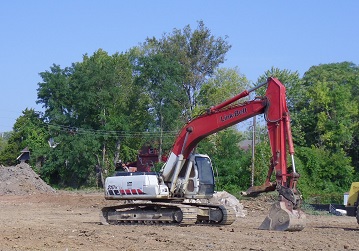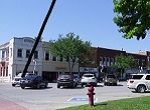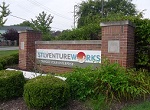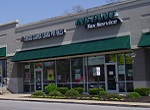Build Economic Development on Realities, Not Myths
Last Updated: January 3, 2025
Economic development projects and conversations often are based on magical thinking and 45-year-old industrial attraction formulas rather than data and information about how the real world works now.
Our purpose in this section is to help hard-working businesspersons, community folks, and government officials avoid activities that bring no real outside income into the community. These efforts sometimes spend plenty of money to achieve very little of the promised job creation and business expansion.
So use the grid below to find a sub-topic, continue reading this article after the grid, or search the site using the box at the top or bottom of the page.
Topics in This Section: Definition of Economic Development -- Economic Base -- Location Quotient -- Business Attraction -- Business Retention -- Retail Attraction -- Tourism and Economic Development -- Innovation Districts -- Shopping Center Renovation -- Community Poverty -- Community Attachment -- Economic Development Incubator -- Entrepreneurship Definition -- Entrepreneurship Support -- Commercial District Revitalization -- Commercial Corridor Redevelopment -- Benefits of a Business Improvement District -- Arts and Economic Development -- Higher Education and Economic Development -- Maker Spaces -- Night Mayor -- Community Development Banks -- Vibrant Downtown Ordinance
Start with These Topics in This Section:
Some of you will be interested in specialized situations, including particular concentrations in your economic base, business financing, or rejuvenating a downtown or shopping center. Check out the photo links below for other topics you may find interesting.
We want to give you the analytical tools you need to determine what is worthwhile, what can happen solely through the force of a businessperson's perseverance, and what needs a little nudge from a government, private development organization, or public-private partnership.
We hope you'll study our definition of economic development, which involves adding to the economic base, for the good of your city, town, or area as a whole.
Economic base means the jobs you generate and income you earn when you produce goods or services in your community, but sell to people beyond your community. Important examples are manufacturing, tourism, higher education, and services sold beyond your community.
 Does big construction equipment automatically mean economic development? We don't think so.
Does big construction equipment automatically mean economic development? We don't think so.Often people think they are practicing economic development when they engage in business attraction or retail attraction.
Community leaders tick off the benefits of their business programs: jobs for residents, places to shop, and business
owners or managers to approach for donations to assist your community.
You have a right to question these statements. We notice that politicians often cite the number of jobs that have been created while they have been in office. But we the public have every right to ask how many jobs have been eliminated through automation, relocation, or dissolution of the business during that same time frame.
Not all businesses contribute to the all-important economic base. You might have heard that we can't thrive by simply selling hamburgers to each other. This thought is correct; hamburgers provide jobs, but mostly, they are sold to the locals.
Worse, just a few owners sell most of the hamburgers, and odds are, those corporate headquarters are not in your town. Selling burgers is economic development only in tourist towns.
An economic base activity is one in which your community has a specialty. You can determine which activities are "basic" through calculating a measure called the location quotient.
As an aside, the whole idea of business clusters is important to address, even in a smaller city. A cluster consists of businesses logically grouped together because they are similar, related, complementary, or up and down the supply chain from one another. If you need help identifying these clusters, as many concerned citizens and elected officials would, a state university or extension office should be able to find some assistance for you.
Keeping Business Attraction in Perspective
Business retention and entrepreneurship support programs deserve the greatest investment of your time and money. Rather than producing those colorful expensive ads, your chamber of commerce should be concentrating on serving the economic base businesses that are there already, and developing a culture that supports new business ideas.
Only when business retention has been addressed and re-addressed on a regular schedule should you even think about business attraction.
Too many chambers of commerce, cities, and neighborhood associations think they need to devote major blocks of time and money to "marketing" and "branding" themselves, and then somehow, someday, the right people magically will notice them and relocate.
Generally you are much better off thinking about business retention, improving quality of life measures relevant to businesses in your economic base, and encouraging individuals who are laid off, approaching retirement, tired of the commute, or stay-at-home moms to start businesses. Then the "non-basic" (not part of the economic base) activities will find you.
One important exception to the rule of leaving business recruitment to the market is when you are lacking in essential services. This may happen because you live in a distressed neighborhood, rural area, small city, or a somehow-overlooked rapidly growing community.
Markets aren't perfect, so they don't always notice sufficient demand the instant it arises. It's your job to point out that demand, if you lack a grocery store, dry cleaner, restaurant attractive to management and workers in your economic base activity, or health care provider.
Entrepreneurship: The Best Way to Improve Your Economy
If you are a community devastated by the disappearance of manufacturing jobs, or other jobs unlikely to replaced, you especially need to consider an entrepreneurship program. An entrepreneur simply means a person who starts a business. We elaborate a bit on an entrepreneurship definition and characteristics on another page. Incidentally, we are not talking about explosive growth technology firms or the guys and gals who work to build a business and then sell for fortunes in a few years. That could happen, but chasing after those few businesses is just as silly as looking for an industry to steal from your neighboring community. Here we are thinking more about one or two person founders in the early stages of business formation and maturity.
Small business creates as many as 90% of the jobs in some years. And in the immediate aftermath of the Great Recession, new businesses were doing all the net job creation in the U.S.!
Often creating a friendly ecosystem for entrepreneurs occurs at the citywide or regional level. Yet neighborhood associations have teamed up with other groups in their city effectively to find a good entrepreneur training program and offer it frequently.
This is your best chance if your economic base is gone. Unleash the creativity of your people. Most community organizations or local governments don't have experience in creativity and innovation training or in teaching business planning.
A local foundation or university could work on a template for addressing that gap. A faster way is to find a few talented businesspersons who could give a series of presentations.
Also in support of entrepreneurs, even small cities can manage a high-quality business incubator (also called an economic development incubator or business accelerator).
Take the four to eight people in town who are considering starting a business, screen those ideas, and put the ones with promise together in one run-down building that your community association paints and repairs to an acceptable level on Saturdays.
Add common services and a knowledgeable manager skilled in working with start-ups. If you have abandoned factories, incubators offer the attractive bonus of providing a potential adaptive reuse.
Of course the other thing entrepreneurs need is a source of capital. If your neighborhood lacks lenders for very small enterprises, you might want to learn about microloans. Microfinance is available in the U.S. through the Small Business Administration and also through a variety of community organizations.
On the city scale, you need sources of seed capital, to support the entrepreneur while he or she is producing business plans and prototypes, before venture capital and other business loans are available. If adequate capital for building businesses from the ground up seems to be missing in your medium sized to large city, form coalitions to generate start-up funds.
If you are in a major city, you may be able to accomplish business growth, with corresponding employment growth of course, through establishing an innovation district. This specialized environment design to stimulate and support innovation is not for everyone, but you can read our page on this topic to determine if this approach is worth the major time and effort required to start such a physical, economic, and social project and watch it grow. This differs from start-up incubation and entrepreneurship in that well-established firms with a culture of generating innovation may be part of the mix.
Tourism as a Source of Economic Growth
In our definition of the economic base you will notice that tourism and business growth are natural companions.
Many places have more tourism potential than they are taking advantage of. If you have any tourism base, think carefully about what it is, and try to expand it logically.
If scenery is your stock in trade, how can you differentiate yourself from all those other beautiful mountain communities? What do you do better? Do you need to add festivals? Or should you add a spa? Or do you need to say no to those fast-food places and monster signs that would ruin your gorgeous view? Are a certain price of accommodations missing from your community?
Maybe your most touristy section of town is lacking in nightlife. Then you should consider a night mayor, whose office can be responsible for growing nightlife and dealing with the problems that accompany it.
If you really talk with your visitors about why they come to the mountains, you can perhaps find a compatible economic activity and thus have a focus to your tourist attraction efforts.
In another situation, consider developing a link between arts and economic development. This strategy can be employed in distressed urban neighborhoods, where a major city can support at least one arts district expressing the local minority or indigenous culture. Thinking about positioning your area in this way is also viable for abandoned buildings, small towns, neighborhoods already possessing at least one arts venue or asset, downtowns, and areas near universities.
Incidentally, the entire U.S. is lagging its potential in international tourism.
Reinvestment in Downtown and Other Retail Areas
Investing in downtown redevelopment, using any available state programs or tax credits, has value in and of itself because it helps prevent expensive suburban sprawl and takes advantage of the investment prior generations have made.
It also gives civic pride a lift, because now your residents will be happy to claim that wonderful mix of vibrant human activity in a block or two, or 100 blocks. Downtowns are your gathering place too.
More importantly, perhaps you can bolster locally owned businesses, so that the return on investment remains in your community. You can encourage new businesses, artists, non-profits, and civic uses to locate on the side streets.
Commercial district revitalization succeeds in both downtowns and other types of business districts when there is clear-eyed consideration of basic principles of managing the multi-owner district.
If your commercial area in need of attention is more of a long strip than a relatively compact district where businesses identify with one another, the sharp decline in demand for retail space has led to an urgent need for commercial corridor redevelopment in many highway-oriented strips or commercial areas divided by a wide street but not sharing a particular identity other than the street.
You also may need to address shopping center renovation in older malls, strip shopping centers, and such. We urge such renovation when a healthy market exists, but the center itself is looking old and out of style.
Higher Education and Good Schools as Economic Tools
Education and economic development are natural partners. Business needs a workforce that is literate, not only in reading, but in math and technology.
So if your school system needs improvement, that should be considered a crisis for a local development agency. If schools have a high dropout rate, demand better.
More and more often, research shows percentage of college graduates living in a city as the best predictor of its economic performance. Keep those little ones and adolescents in school, and cultivate the potential link between higher education and economic development at every opportunity. Chances are, your residential college or university itself is a big contributor to your economic base.
Another Use of the Term in Low-Income Neighborhoods
In lower income communities, it's common to speak of economic development as raising income levels of individuals. While dealing with community poverty directly and forcefully is very important, getting people jobs or better jobs does not fit our definition of economic development, but we have decided that this is just a semantic dispute. All should be able to agree that addressing poverty is critical to a community.
Financial asset building for low-income or low moderate-income households makes every kind of sense. Community development banks specialize in this. A somewhat promising approach that could be imitated anywhere that there are financial institutions where savings can be deposited involves setting up individual development accounts. These have a mixed record of success in a pretty narrow range of communities, so do investigate whether this will work in your circumstances.
Government Financial Incentives for Business Location
For communities of all sizes and types, yes, economic development is an important goal because it provides jobs and supports the local population.
But you don't always have to hand giant corporations large subsidies. Learn about the appropriate use of tax increment financing (TIF) and other financial incentives, and then be tough in rejecting all inappropriate requests that don't generate something that the market could support anyway.
In fact, we strongly recommend that instead of providing these giant one-time-only subsidies to specific businesses, try a steady, incremental placemaking approach. If you are not familiar with this term, check out the mini-photo essay on the topic throughout our sitemap page, and then follow the leads that seem to offer your community the strongest opportunities.
Elected Officials and Community Leaders Supporting Business
You simply must start acting if you're an elected official. Economic difficulties in almost every part of the world are severe and in need of resolution.
Community leadership can and should address many of the quality of life issues that are critical when business growth is discussed. It's essential that your people love your town, because their passion shows.
For a fascinating glimpse at what makes people have an emotional bond to their city, check out the new community attachment research. To develop this theme a bit more, consider some often-ignored assets for your economic development program. For example, we are thinking here especially of an outstanding park system, and the role of investing in an irresistible network of urban or suburban green spaces. For more on this topic, see this series of case studies from the Urban Parks Alliance.
- Making and Keeping a Good Community > Economic Development
Join GOOD COMMUNITY PLUS, which provides you monthly with short features or tips about timely topics for neighborhoods, towns and cities, community organizations, and rural or small town environments. Unsubscribe any time. Give it a try.






















